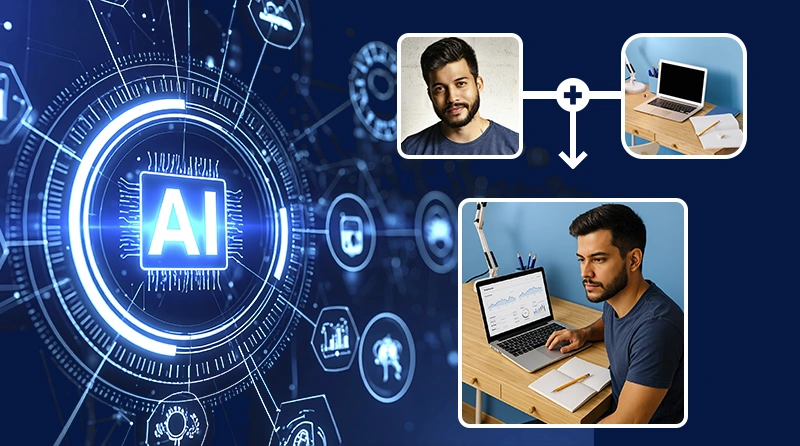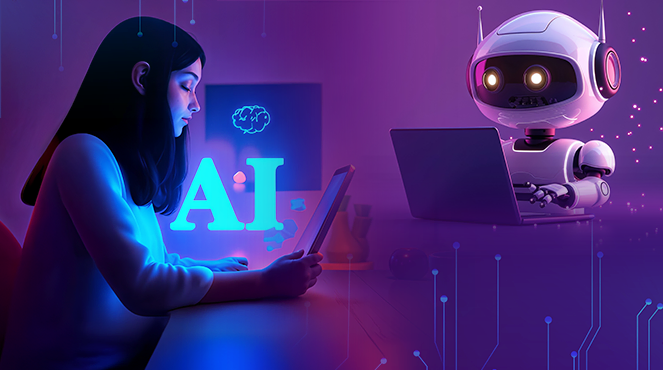How Smart Homes Using AI in India Are Opening Up New Possibilities
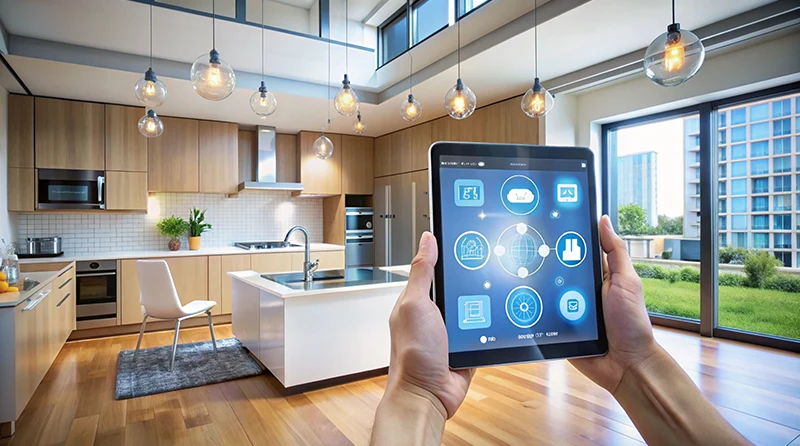
It is such a surprising fact – From controlling lights with voice to securing the home remotely, smart homes using AI in India are opening up new possibilities that are changing how people live, work, and interact with technology every day. The credit goes to the adoption of technology in the Indian real estate landscape, industry initiatives to improve the lives of Indian households, and reduced hardware costs.
According to a recent Statista report, India’s smart home market will reach $9.8 billion by 2029, growing at a CAGR of 7.72% (2025-2029). That’s a clear sign that India’s smart home market will be bigger in the near future than we thought.
The evolution and combination of AI, IoT, and 5G have driven this major shift, where AI acts like the brain, 5G network functions as the central nervous system, and IoT devices work like senses and limbs. AI helps devices in learning and making decisions. The network carries the signal from the central system to the sensors and devices bi-directionally, and sensor-based hardware performs actions that make the smart home process simple.
Indian household automation is becoming mainstream due to 5G availability, the Digital India initiative, security concerns, rooftop solar incentives, and the cross-vendor Matter protocol, which are attracting middle-income buyers.
Another top reason behind the increasing accessibility of smart homes to Indians is industry initiatives taken by Indian brands like Tata, Wipro, and Hero group, including some global brands like Amazon, Google, and Samsung. All these brands have made it easy to adopt IoT-powered devices and made smart living super accessible for Indians.
Now, India is moving forward with its technological advancements and digitalization, where smart home technology is no longer a luxury. Over 15 million homes are already using it, and by 80.9 million smart homes will be in 2028.
Thus, using AI in India to make smart homes is a reality, and in the near future, we’ll witness something amazing. This article explores how smart home tech is shaping the future of living, so let’s continue with the blog.
The Rise of AI in Indian Smart Homes
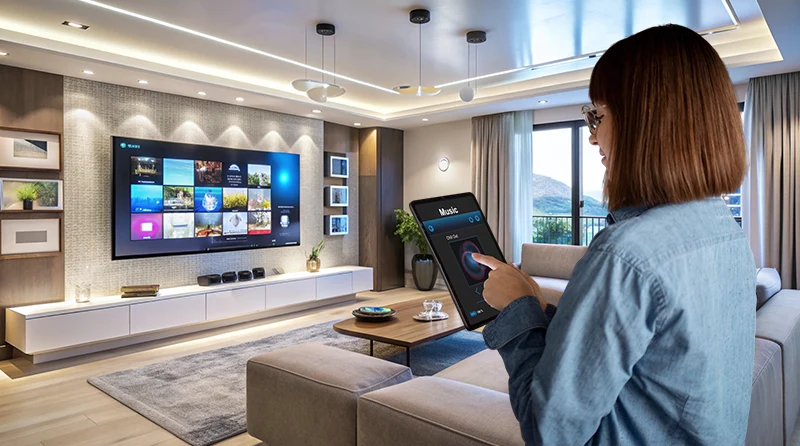
Whatever we’re witnessing today is the fruit of seeds sown by startups in India in the late 2000s to early 2010s. The startup-led innovation helped Indians to adopt the technology to make their home smart. Some of the pioneers are Silvan Innovation Labs(Estd 2008, Bengaluru), offering video surveillance, security, and lighting automation solutions, and Thamsai Automaton(2010, Bengaluru), partnered with Philips and Honeywell to provide home automation, security, and lighting control solutions.
The initial focus was on Tier-1 cities such as Pune, Bengaluru, Mumbai, and Delhi. But now it’s available across India. From 2014 onwards, brands like Oakter, Inoho, and Cubical Labs fueled this growth, utilizing advancements in IoT in India. Now, the rest of the things are open in front of us. You only need to specify what your requirement is, and the service provider will make it available, from simple lighting automation to connect your home with IoT devices that you can control with your voice for security and smart living.
Now you might have some questions, like what are the driving factors and what motivated users to adopt smart homes in India?
Therefore, the driving factors are the rise of smartphones and the internet, and increased affordability with the growth in disposable income. The motivation factors are security, convenience, and increasing energy efficiency in the Indian landscape.
Now, in the market, some top leading brands are covering the smart home needs in India, such as:
- Tata Power(EZ Home): Smart home devices, solutions, smart plugs, and switches, and providing ease of installation.
- Wipro Smart Home: Smart lighting Solutions, IoT smart home solutions, consultation, and installation services.
- Qubo: A hero group venture provides smart home accessories, smart security devices, cameras, and locks.
- Amazon: The global player provides Alexa-enabled voice-controlled home automation solutions, such as the Echo and the Echo Show.
- Okater: Offers smart home products such as switches and plugs that upgrade traditional appliances.
There are other players also in the market catering to the smart home needs in India.
These solutions got high rise after the Pandemic. With remote work, digital learning, and online entertainment becoming part of daily life, people began investing more in comfort, security, and efficiency. AI-powered devices fit naturally into this shift, helping households save time and energy.
This evolution led Indian citizens to a seamless digital lifestyle, and it’s soaring high in terms of existing and future growth.
Now, let’s look at some key market stats and drivers.
Market Overview and Key Drivers of AI Smart Homes in India
From a growth perspective, AI smart homes in the Indian market are growing faster than they were previously. As internet access improves and people get more comfortable with technology, homes are turning smarter. Some key takeaways about India’s smart home market are:
- The household penetration is expected to grow by 87.7% by 2029. [Statista]
- The Indian smart home device market forecast is USD 47.46 billion by 2033, with a CAGR of 24.3%. [IMARC Group]
- The energy and climate control-focused smart home market is projected to grow at a CAGR of 30.34% by 2030.[Mordor Intelligence]
- Over 100 cities in India have adopted smart city solutions by 2025.
- Urban households have higher adoption rates, such as in 2024, the recorded revenue share was 42.23%, while in Tier-2 and Tier-3 cities, the smart home adoption rates are gradually increasing. [Mordor Intelligence, Future Market Insights].
One of the key factors that has fueled this growth is the emphasis on cost-effective solutions customized for local consumers, and the supporting elements are the Digital India initiative by the Government, the roll-out of 5G technology, and easy access and purchase of smart devices to make homes smarter.
The growth drivers are:
- Increasing Urbanization: Urbanization in India is rapidly growing, and by 2050, it is anticipated to reach 50%. This rapid shift demands smarter living solutions, and the service providers consider it a great opportunity while providing the solutions.
- Rising Disposable Income: India’s disposable per capita income is rising, and also cost-effective smart home solutions, which allow middle-class families to choose smart home solutions that fit their needs.
- 5G Revolution: With the intro of 5G technology, connectivity is not an issue, and people can easily manage their smart home devices using their smartphones.
- Government Initiatives: GOI’s initiative “Smart Cities Mission” is one of the growth-driving factors. Due to the increasing infrastructure, it’s easy to adopt smart home technology.
- Home Security Concerns: Rising crime in urban cities has drawn the attention of citizens towards robust security solutions, and AI-powered smart home solutions are the best for it. People are now using AI-driven smart cameras and locks.
- AI and IoT Integration: In technology implementation, India is now one of the most progressive countries and experts available for AI and IoT integration from the smart home implementation perspective.
Is India really growing in smart home implementation? Yes, of course. All mentioned stats are enough to claim it, and the future will be bright.
So, what are the key technologies that make innovations possible? Let’s know it in the upcoming section of this blog.
4 Key Technologies Driving Smart Home Innovations in India
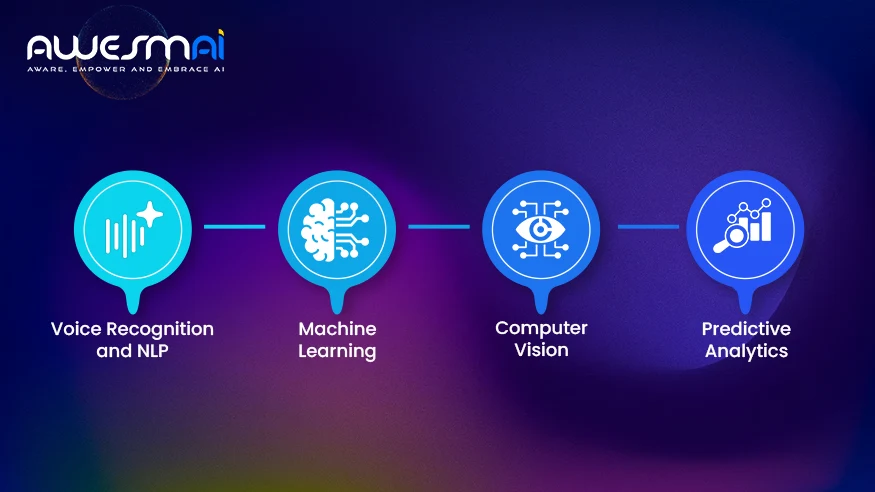
Smart homes are no longer just turning devices on and off remotely. There is equal contribution of technologies such as Artificial Intelligence, Cloud Computing, Edge devices, and the Internet of Things, aka. IoT.
So how does it work? Let’s simplify things.
IoT devices connected in a closed network collect data through sensors, such as motion, temperature, and sound sensors. The collected data is sent to the cloud or edge devices, and there, AI-powered algorithms perform actions. As a result, your home becomes smart, from turning off lights to detecting any suspicious movement in your courtyard and sending alerts to your smartphone.
Let’s break it down deep in terms of technology.
1. Voice Recognition and NLP
Did you know smart devices like Alexa are multilingual and detect diverse dialects from Hindi to Tamil or Bengali? In the background, the Natural Language processing subset of AI makes this possible. Research shows voice-recognition schemes combined with IoT devices improve accessibility and user experience in smart homes.
2. Machine Learning
Machine Learning works as the backbone for AI-driven smart home systems and learns through your actions from the day it starts till you sleep, what AC temperature you prefer, and even when you lock your main door. The more you use it, the more the system learns accordingly.
3. Computer Vision
Another technology that really makes the home smart. Remember, the facial recognition system at your office lets you in on the floor. But at your home, it will unlock the door for you and your family. Computer vision is for identifying images and facial features, especially for smart door locks. It also helps security cameras detect and monitor movement when you leave the home.
4. Predictive Analytics
What if your systems predict water consumption or energy use? Yes, smart homes in India are using predictive analytics for it, and the concept is simple, i.e, Prediction against a reaction. The simplest example- Your master bedroom’s AC learned about your timetable and adjusts the temperature according to your sleep schedule, or sends you an alert to check any fluctuation in power supply.
Smart homes using AI in India have opened up new possibilities, but who has made it possible for Indian consumers? It is India-based tech collaborations, such as:
- Jio and Plume collaborated to deploy smart home and business services using Plume’s AI-powered platform.
- Airtel and Intelismart partnered to provide smart meters, where Airtel Bharti will take care of IoT, Cloud, head-end system, and analytics.
- ABB India partnered with major global brands such as Samsung, Philips, and Sonos to expand its wireless home automation solutions for consumers.
These are just a few examples; there are others that also exist, such as Schneider Electric SE, Siemens AG, Honeywell International Inc., and Emerson Electric Co. Although these are international brands, they have a strong presence in the Indian smart home market.
5 Benefits of AI-Driven Smart Homes for Indian Consumers
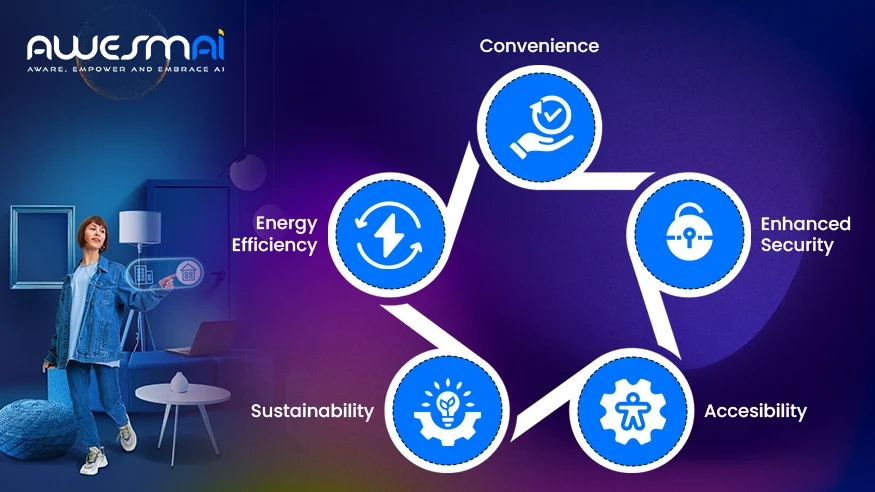
AI-driven smart homes bring real value to everyday life, such as saving electricity and improving home security. These systems are making life simpler for Indian families.
1. Energy Efficiency
Automatic lighting and temperature control can cut down electricity use without much effort. For example, Wipro Smart Bulbs adjust brightness depending on daylight, and smart plugs turn off unused appliances. Small changes like these make a noticeable difference in power bills.
2. Enhanced Security
Security is one of the strongest reasons people in India are turning to AI-based devices. Products such as Qubo AI Cameras or Godrej Smart Locks alert homeowners about unusual activity or unknown visitors. Many systems even allow you to watch live camera feeds while you’re away.
3. Convenience
Everyday chores are easier when devices listen and respond. Whether you ask Alexa to switch off lights, tell Google Home to play music, or use the Tata Smart Home app to manage appliances, control is always in your hands.
4. Accessibility
Smart home devices make life simpler for differently-abled and seniors too, such as turning off lights to calling for help whenever they need through caretakers or from their family. For example, giving voice commands to Alexa to turn on the bedroom lights or opening the curtains using smart blind automation.
5. Sustainability
Utilizing predictive analytics and machine learning, AI-driven smart home systems help with energy efficiency through energy monitoring, water conservation through leak and overuse detection, smart irrigation, and waste reduction through waste stream analysis, collecting data through smart trash.
5 Key Challenges and Considerations in AI Smart Homes
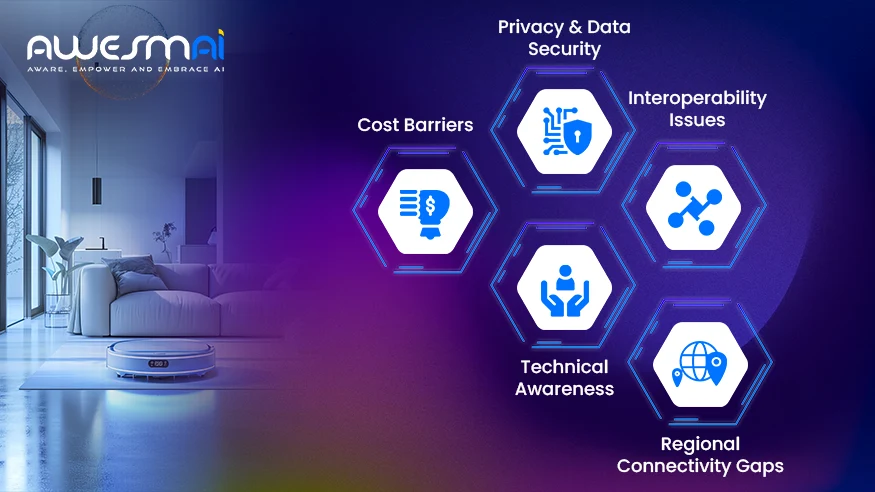
While AI-powered homes are becoming more common, many Indian consumers still face a few real challenges before they can fully enjoy the benefits.
1. Cost Barriers
Affordability is still a challenge, as most of the devices are imported and fall in the premium range. Although local brands like Wipro and Qubo by Hero Group are providing it at an affordable cost, it still has an upfront cost, such as hardware purchase, installation, upgrades, and subscriptions. It bars lower-income households from adopting smart home solutions in India.
Tip: You can start small instead of upgrading the entire home, for example, start with Wipro’s smart bulb, and later you can move to further upgradation.
2. Privacy & Data Security
It’s true that smart home devices collect data consistently, such as audio, video, schedules, and preferences. So, if there is any loophole in the system, your privacy will be at stake. Usually, the data is stored on cloud servers, and inadequate security, surveillance, and encryption can create havoc.
Tip: Always choose tested and trusted brands that tell how they protect and use consumers’ data.
3. Interoperability Issues
Interoperability is also a challenge, as it may happen that you’re using smart home devices that came from different ecosystems. For example, Google Assistant may create issues with Amazon or Apple devices.
Tip: The smarter choice is to use devices that support the Matter protocol for seamless cross-platform compatibility.
4. Technical Awareness
India is the fastest progressing country in terms of industries, finance, and technology. Still, a portion of the population is not technically aware of setup, use, and maintenance. Thus, sometimes it creates issues.
Tip: Consumer walk-through training, step-by-step setup guides, and effective customer support are the only solutions.
5. Regional Connectivity Gaps
Although in India, 5G mobile network and WiFi are trending and cover a wide area, still in Tier-2 & Tier-3 cities, the internet infrastructure is not capable of supporting smart home devices, where high speed is required to keep all devices in sync.
5 Case Studies – AI Smart Home Success Stories from India
Now, let’s have a closer look at some real case studies or success stories of some brands that have set the examples in smart homes using AI in India.
Case 1: Tata Smart Home Solutions – End-to-end integration with energy management
The Tata smart home solutions brand is a subsidiary of Tata Power and provides solutions in the name of Tata Power EZ Home. The motive of the brand is to let common indian consumers use affordable smart home solutions.
Key Features:
- Better energy savings and management (ex., reduce electricity bills by up to 20%)
- Ease of use and remote control convenience
- Easy installation and affordable solution
- Overload protection
- Voice control through Google & Alexa
- Scheduled time automation
How does it work?
It is an integrated smart home ecosystem that connects lighting, energy management, and security through one platform. So, the tech-savvy and non-tech-savvy users can use it at their own convenience.
The Tata Home EZ devices are available at key retail ecommerce channels such as Amazon, Flipkart, and Croma at an affordable range.
Case 2: Zunpulse – Indian startup making affordable AI-powered devices
Zunpulse is one of the top names in “Made in India” smart home solution providers, founded by IITians Pranesh Chaudhary and Sushant Sachan in 2020. The brand has addressed key challenges of the smart home market by focusing on affordability and easy-to-install “plug-and-play” technology. An entire ecosystem can be controlled by a single app, making it simple for anyone.
Key Features:
- Single-app ecosystem
- Affordable devices, i.e., start from under ₹1,000
- Simple plug-n-play approach
- Highly energy efficient
- Diverse product range for all types of customers
How does it work?
From AI-powered smart home cameras to kitchen appliances, all are controlled by a single app, eliminating the hassle of managing apps. Once the devices are installed, you only need to download it from the Apple App Store or Google Play Store.
Providing affordable smart home solutions in India since 2020, till the previous year, the company has raised $3.32M [Tracxn[dot] com].
Case 3: Qubo by Hero Group – AI-powered cameras and smart automation tailored for India
Qubo is the subsidiary of Hero Group’s electronic division and supports “Make in India” completely in terms of AI-powered smart cameras and smart home automation. The company’s focus is on affordability, security, and automation. Compared to the foreign brand, the company succeeded in providing smart home products aligning with indian households’ values and environment. The USP is to make smart cameras, security devices, and voice-controlled automation affordable for the middle class.
Key Features:
- “Made in India, For India” approach
- AI-powered security
- Committed to data privacy
- A diverse product ecosystem with affordability
- Seamless integration with Google and Alexa
How does it work?
A homegrown app facilitates users to control all Qubo smart devices and comes with integrated Alexa support. Thus, users can also control devices through simple voice commands.
As a success in providing solutions for its own country’s citizens, the company has crossed ₹275 crore in FY25 [ET Retail], and continues on the path for further expansion.
Case 4: Godrej Smart Locks – Blending traditional Indian trust with modern AI security
Godrej is another legend serving India since 1897, and it has also earned trust in providing AI-powered smart home security solutions, including locks, home lockers, video door phones, and smart alarm systems. All products are designed to align with Indian home environments.
Key Features:
- Fingerprint and facial recognition access
- Built-in alarm and motion detection
- Tamper-proof design
- Smartphone-based control and monitoring
How does it work?
The AI-powered mechanism matches the facial, finger, or both patterns and allows users to unlock the doors. In case of any aggression with the lock, the system sends real-time alerts to the user’s screen.
With a high success rate, Godrej Security Solutions has achieved revenue of over ₹1,200 crore in FY25 and is now targeting 15% growth in FY26. [ET Retail]
The Future of AI in Indian Smart Homes
Despite the challenges such as cost, complexity, interoperability, and others, the smart home market in India has achieved significant growth. The future of AI in Indian smart homes is promising due to the evolution of technology, innovation, the rise of tech Indian startups(Oakter, Zunpulse, Qubo, etc.), and collaboration with global brands. The key driving factors are comfort, convenience, security, and energy efficiency.
Here are some key trends to consider.
1. AI and Renewable Energy
With initiatives like PM Surya Ghar, Indian households are moving forward to sustainable energy options. In the near future, the AI-powered smart home devices will be integrated with solar energy, will be able to monitor renewable energy consumption, and store solar power for later use. It will help reduce energy consumption, electricity bills, and support green energy goals.
2. Emotion Detecting AI and Ambient Computing
The AI will be more capable of understanding human emotions, and devices will be able to adjust temperature, lights, or music based on the mood. Ambient computing will be on the rise, utilizing voice and gesture recognition, motion tracking, and interconnected devices for creating a seamless automation experience without constant interaction.
Ex. Voice assistant starts the coffee maker based on the morning alarm.
3. Local Language Voice Assistants
Voice control is one of the key features of any smart home system or device, and in the future, it will be further improved and personalized by adding more local languages. Including the major languages Hindi, Tamil, and Bengali, the devices would be able to support diverse dialects and regional languages with improved NLP capabilities.
4. AI and Smart Grids
The Indian government is now moving forward to make cities smarter with all types of infrastructure facilities. Thus, in the future, the role of AI will be significant in managing smart cities and power grids. Homes will be able to directly communicate with the centralized systems using IoT and sensors. Detection of outages, energy consumption, and energy saving will be easy.
Still, there is a question about Tier-2 and Tier-3 cities.
Indian startups are already on to make smart home systems more affordable. Companies like Qubo, Zunpulse, Okater, Inoho, and others are focusing on expansion, so the technology will also be available for Tier-2 and Tier-3 cities.
Conclusion – India’s Smart Living Revolution Has Just Begun
Smart Homes using AI in India is not just a tech trend; it is the reality now, and people are interested in it for a lifestyle upgrade. Not only for luxury and comfort, AI is making homes safer, greener, and more intelligent.
The credit goes to the homegrown brands such as Tata EZ, Qubo, Wipro, Godrej, Zunpulse, and others. Including the government efforts, all these brands are pushing forward to make life secure, energy efficient, and sustainable, reducing energy consumption and increasing power savings.
In the near future, the mix of AI, IoT, and renewable energy will help Indian families live smarter and greener even in Tier-2 & Tier-3 cities. With collaborations among brands, the future of smart homes in India is bright, and the next five years will be game changers.
With local innovation and AI advancements, India is on track to lead the global smart home revolution.
So, what are your views, and are you ready to be a part of this smart living revolution?
Frequently Asked Questions (FAQs)
What is a smart home, and how does AI enhance it?
A smart home refers to the use of interconnected AI and IoT-enabled devices and automated systems. The entire ecosystem helps with control and monitoring, where AI makes the system learn and adapt to users’ behavior to provide convenience to the users. AI enhances it through voice recognition, facial recognition, predictive maintenance, and energy management.
Which AI smart home devices are popular in India?
Some of the most popular devices in India are:
- Tata Power EZ Home Automation Kit
- Godrej Spotlight Cam 360 for AI-Driven Surveillance
- Philips Hue Smart Lighting for AI-Personalized Ambience
- Amazon Echo Dot
- Godrej Smart Locks and more.
How much does it cost to build a smart home in India?
There is no such straightforward answer about it, as the cost to build a smart home in India depends on factors such as home size, number of devices and types, installation cost, and features. However, an average range or ballpark estimate is of ₹30,000 – ₹5,00,000+.
Are AI-powered smart homes secure?
Data privacy and security are one of the key challenges for smart homes, but AI can help to improve the security through advanced threat detection not only to the homes, but also to the data. The service providers are also focusing on providing secure solutions using technology and innovation.
What’s the future of AI in Indian home automation?
The Indian smart home market size is forecast to reach USD 19.31 billion in 2030, focusing on self-learning home automation systems, with enhanced security, better energy efficiency, and low consumption. Therefore, the future is bright.






